Books and products mentioned in oldhouseonline stories are chosen by our editors. When you buy through links on this site, we may earn an affiliate commission.
The old joke about how many people it takes to change a light bulb takes on new meaning as lighting technology continues to evolve. Happily, you can beat the blues and buzz.
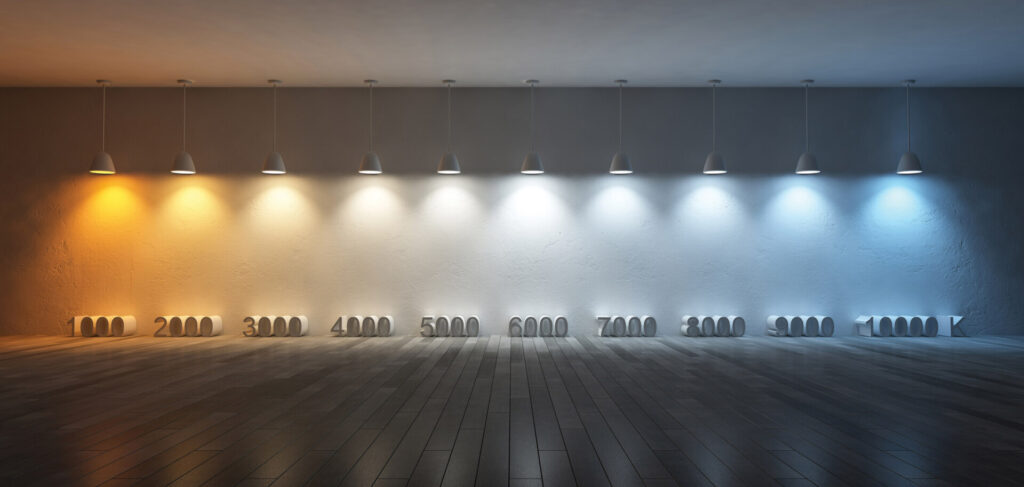
Ohsuriya/Adobe Stock
I had tried just about every LED bulb available online for my 1910 dining-room shower fixture—but none, not even the filament-style Edison bulbs, looked soft and inviting when dimmed. When fully illuminated, the bulbs produced glare. Bulbs with the same color temperature—the so-called “warm” 2700 Kelvin—looked blue or grey when lit. Worse, they weren’t the same color of blue or grey, something quite noticeable in a multi-lamp shower fixture with glass shades. Some bulbs buzzed when dimmed. Replacing the bulb that buzzed often meant that the new bulb flickered while the others didn’t.
Fed up, I headed to my local hardware store to search for 2200 Kelvin LEDs, the “warmest” available. No luck. I kvetched about the problem to Mike, the guy behind the counter.
He asked me if I wanted lights that were warm when dimmed. I said yes. He paused briefly to see if anyone else was in view, then reached under the counter and handed me a set of four light bulbs he was certain I would like.
They were incandescents.
Mike probably treated the bulbs like contraband because in some states and municipalities they are. Depending on where you live, incandescent bulbs are banned or sales are restricted. (Same goes for some types of fluorescent lighting, and halogen lights are being phased out as well.) In some cases, electricians are required by law to install only LED lighting in new construction, which includes additions to older houses.
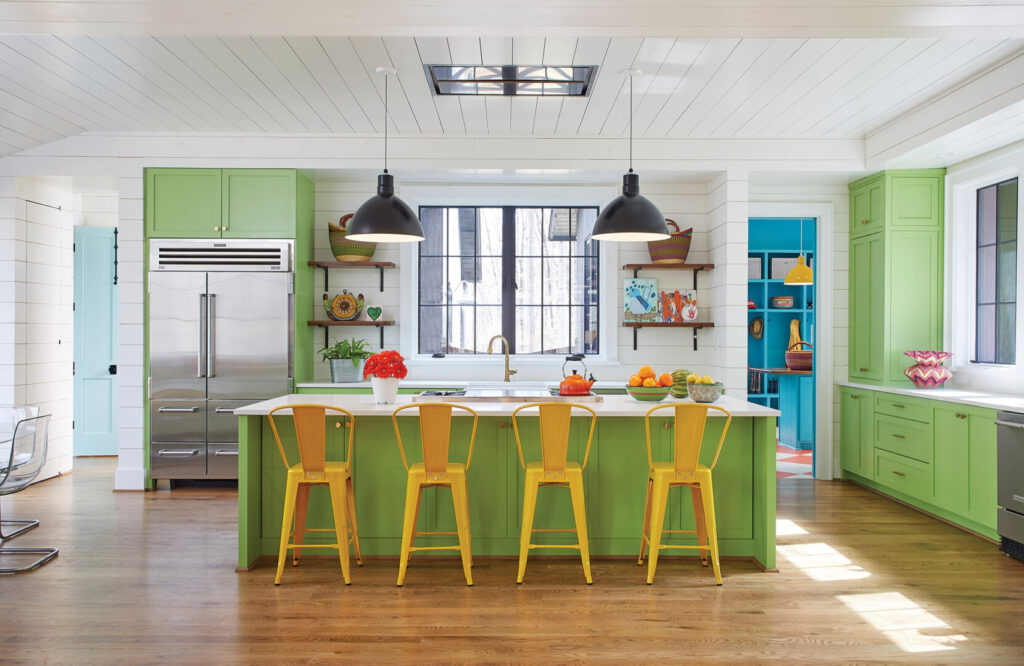
Jean Allsopp
Pro Tip: When buying a dimmable fixture, get a recommendation from the merchant or manufacturer for a dimmer that’s compatible. Otherwise, you may hear buzzing when the light is on, or when dimmed to certain settings.
Smart, wifi-enabled LED bulbs that shift color; dimmable LEDs that mimic the effect of an incandescent; an integrated LED light source that’s part of the fixture itself (including some period reproductions); Edison-style LED bulbs: these are some of the recent innovations in home lighting.
No one questions that LEDs have lifespans measured in years rather than hours, and use far less energy and are much less expensive long-term than older forms of lighting. But the knock on LEDs is that the color cast by the bulb doesn’t soften and mellow at lower levels of illumination. “If you look at an incandescent bulb, it gets warmer and redder in color when it’s dimmed,” says Craig Richard of Old California Lighting. “LEDs don’t change color like that.”
One problem is that earlier versions of LEDs did not offer a full-spectrum light source. Most manufacturers now offer lights that score high on something called the Color Rendering Index (CRI), which measures how accurately the light source reproduces colors as they would appear in natural or incandescent light. The higher the CRI value (80 or above), the more pleasant the lighting.
See a shop tour: Old California Lighting
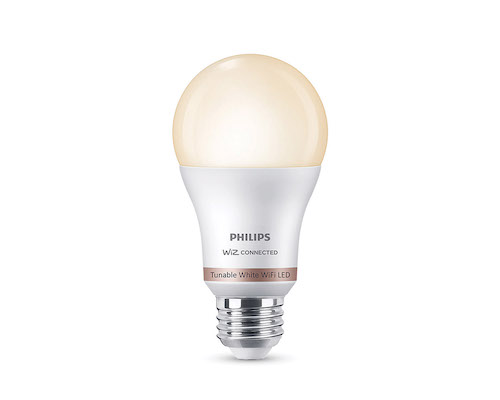
Other bulb manufacturers have responded by offering “smart” wifi-enabled LEDs that shift color to mimic the change of natural light during the day. These tunable bulbs work with voice-activation apps, including Alexa, Google Home, Siri, and Echo, although as yet no one bulb works with every voice-activation system. Perhaps the biggest news, however, is “dim to warm” technology.
Philips recently introduced the Warm Glow, a dimmable A19 LED that screws in just like an incandescent bulb. The 800-lumens/60-watt equivalent bulb “works with more dimmer switches than any other LED on the market,” meaning it may or may not work with yours. What’s significant is that as the bulb dims, the light diminishes from 2700 Kelvin to 2200 Kelvin, arguably the same effect as dimming a regular incandescent bulb to candle glow. Early reviews are generally good. When dimmed, “many LED bulbs just get darker, which has a very cold effect,” writes Adam T.S., a reviewer at amazon.com. “These bulbs get warmer as the lights dim.”
That’s just bulbs that screw into existing fixtures. It’s now possible to buy vintage-look fixtures with integrated LEDs, where the light source is part of the fixture itself. Barn Light Electric, for example, offers integrated LED lamping as an option through a built-in module on most fixtures with shades 12″ wide or more. “There’s no bulb to change out,” says Paige Perigo, retail customer-care supervisor for the company.
“Each fixture has a dedicated driver.”
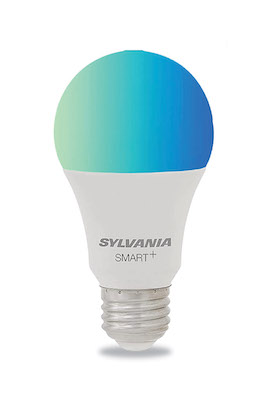
Barn Light’s integrated LEDs come with a choice of a flat or domed lens and are guaranteed for 50,000 hours of service. That equates to 10 to 20 years or more, depending on daily usage. The company will also replace the module at the end of its life without sacrificing the fixture.
Those not ready to make the jump to integrated LEDs still have the option of lamping the fixture with screw-in LED or incandescent bulbs. And while not yet perfected, a dim to warm option is in the research and development stage at Barn Light, Perigo says.
Other vintage lighting makers are quietly offering LEDs as an option in certain fixtures. Vintage Hardware & Lighting’s Delancey Theatre lights, for example, can be wired for either incandescent or a dimmable LED tube that complies with strict California lighting standards. The company also sells LED tubes that retrofit neatly into some old fluorescent pillar or hanging fixtures.
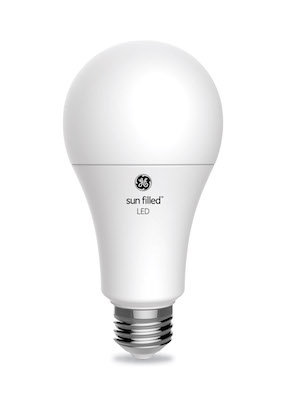
Still others have yet to jump on the integrated LED bandwagon. One is Old California Lighting, known for its art glass and mica fixtures with metal overlays. “We were avoiding [going to LEDs] because it was fighting with the look of our lamps,” says Craig Richard. “When you put a blue light behind amber art glass, it makes it look green.”
The cool look of most LED bulbs and modules is more forgiving with lighting styles like Mid-century Modern, Streamline, and Art Deco, possibly because of the glasses and metal finishes used. House of Antique Hardware’s mid-century-inspired Impulse chandelier, for example, is lit by 30 LED emitters housed in globes at the tips of slender stems. Although the design is up to the minute, it would look right at home in a 1955 Ranch.
House of Antique Hardware also offers something I wish I’d known about six months ago: Edison-style LED bulbs rated for 2200 Kelvin, the warmest light possible with LEDs. I have four on order.
Unplanned obsolescence?
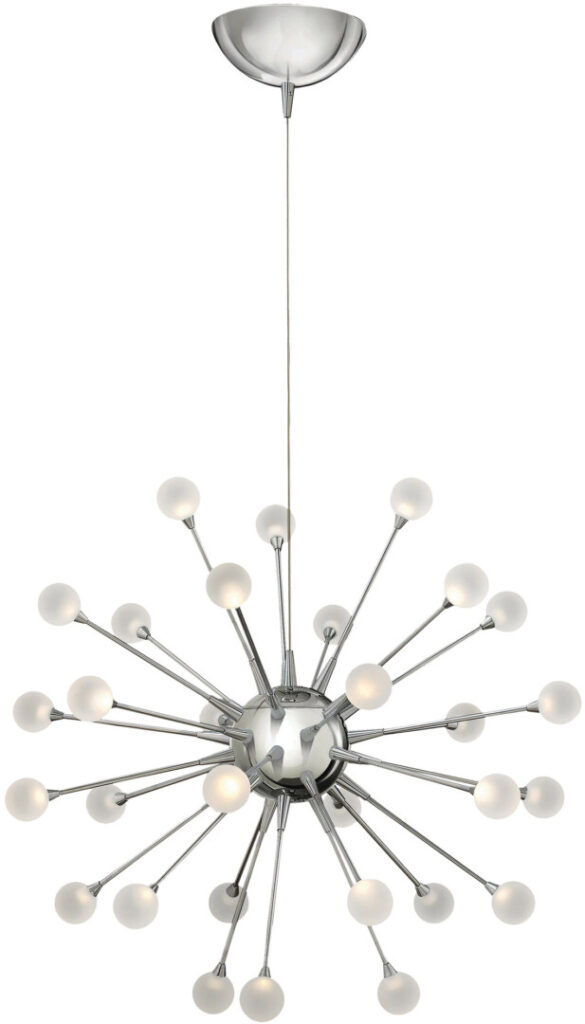
Fixtures with integrated LEDs have been around for a decade, but they’ve been slow to catch on, especially in the reproduction-lighting market. The reason? When the lighting module powering the light fails, it’s likely the entire fixture must be replaced.
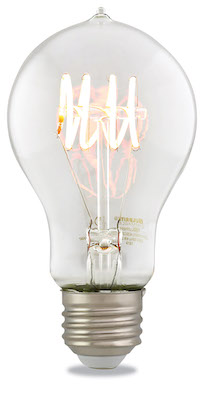
near the warmest end
of the color spectrum,
is from House of
Antique Hardware.
That’s because an integrated LED is built using circuit-on-board techniques (newer versions are going chip-on-board, or COB). That means if a diode in the fixture stops working, it cannot easily be removed and replaced. Some manufacturers, including Barn Light Electric, will replace the appropriate parts if the module on a LED
fixture they make blows out. For others, check the warranty before you buy.
The right Kelvin
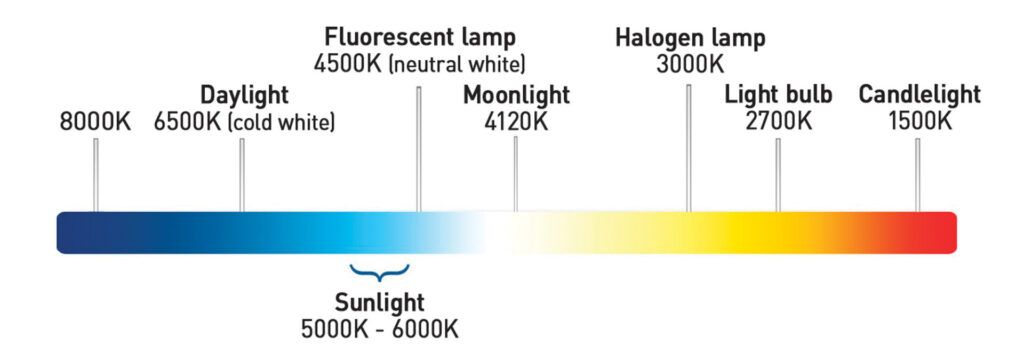
In color temperatures that range from roughly 2000 to 5000 Kelvin, LED bulbs come in all shapes and sizes. The lower the number, the warmer the light, and vice versa. While bright, cool light up to 5000 Kelvin is desirable in commercial spaces where plenty of light is essential, household lighting is typically 2700 to 3500 Kelvin, according to the Retrofit Companies, a lighting design specialist. “We don’t want a residential customer going over 3000 Kelvin,” says Barn Light Electric’s Paige Perigo. That’s because bright, cool light on the blue side of the spectrum can not only feel uncomfortable, but also may disrupt circadian rhythms, interfering with sleep. Lumens matter, too: To get the right combination of soft illumination in an interior fixture, she recommends no more than 850 lumens. That’s the energy-sipping equivalent to a 60-watt bulb.
SPOTS: smaller & prettier
While even those in the lighting industry still refer to recessed spot lighting as “can lights,” today’s versions perform better and are a lot less obtrusive than the 10″-long monstrosities sold in the 1970s and ’80s.
Options include screw-in LED bulbs, GU-24 pin bulbs, and integrated LED fixtures. Once you remove the surface mount, they’re just as easy to remove and replace as an incandescent bulb. Given the lifespan of a typical LED bulb, replacing one should be a rare occurrence.
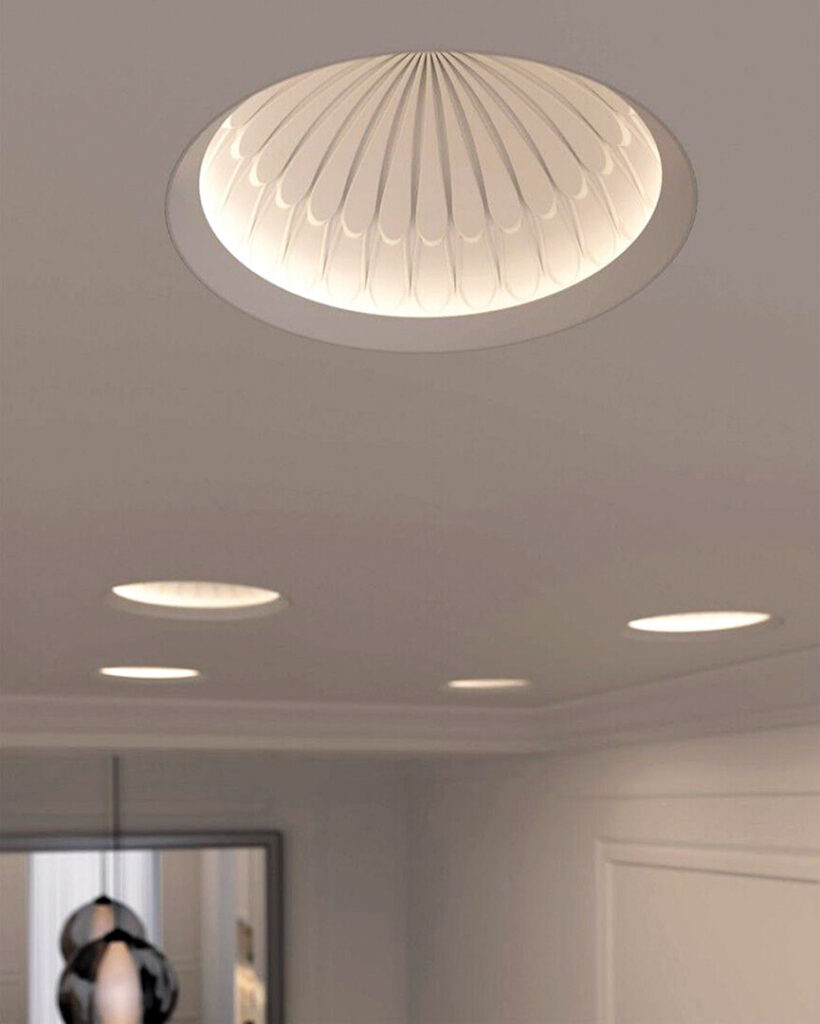
While recessed light fixtures as small as 3″ or 4″ have been available for commercial use for a while, most household spots are still 6″ across. Yes, you can remove them and patch and smooth in new drywall or plaster, but a simpler approach is to replace existing 6″ spots with a decorative LED designed as a retrofit, like Tech Lighting’s Reflections line. Promising warm color dimming and reduced glare, they are CRI rated at 90 or more.
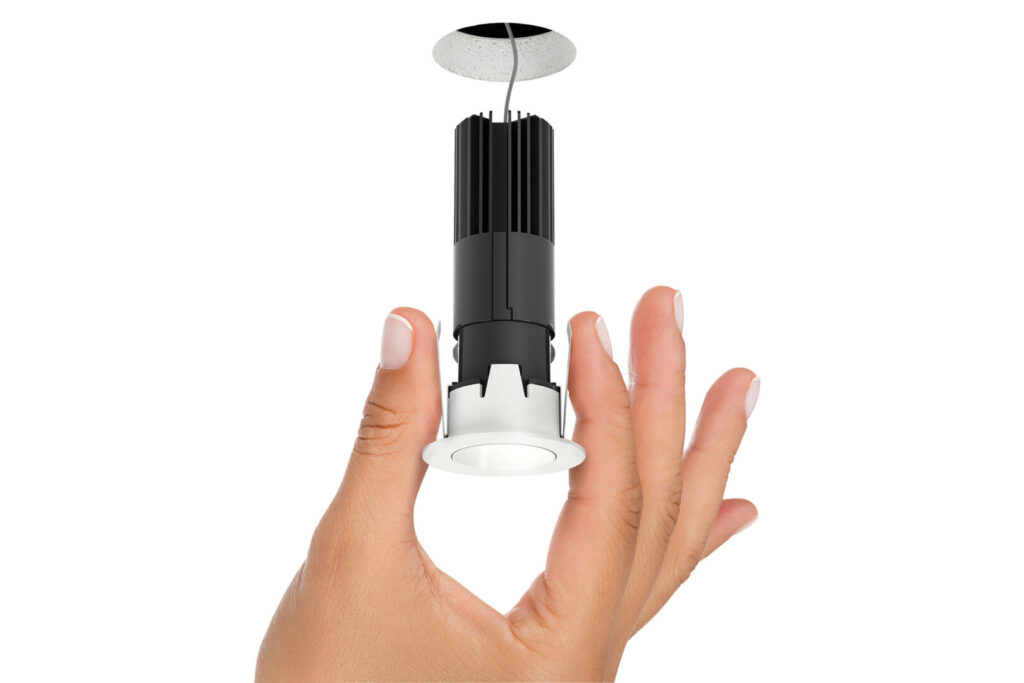
Need a discreet ceiling light where none exists? Consider USAI Lighting’s “the Little Ones.” These recessed spots have a ceiling aperture of a mere inch.
What’s a CRI rating?
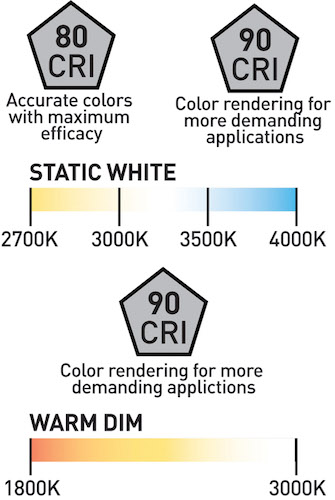
CRI, or color rendering index, is a measure of how accurately a light source such as an LED displays colors. It’s determined by comparing how a bright color (a red apple, say) looks under LED light, as compared to under incandescent light.
CRI ratings range from 1 to 100, with 100 representing natural daylight. A high CRI rating is important when rendering skin tones, particularly if the light is dimmable. Ratings of 80 or more will seem pleasant in residential settings, but for the most accurate colors, choose bulbs with a CRI of 90 or more. (The rating is in small print near the base of the bulb.)
See a shop tour: Old California Lighting







